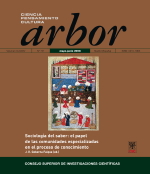Wisdom of Palace and Temple: Scribes in the Ancient Near East and Egypt
DOI:
https://doi.org/10.3989/arbor.2008.i731.191Keywords:
Scribes, Egypt, Ancient NearAbstract
The scribes were specialist that worked to the temple or palace and were indispensable to the administration, but also write and copied the texts that related the actions of govern and were presented to the gods. Scribes that caressed of liberty to write anything that neither was nor approved by the elites of temples or palaces and their work had an acculturation assignment into the norms and values that emanated from the institutions of power.
Downloads
References
Assmann, J. (1995): Egipto a la luz de una teoría pluralista de la cultura, Madrid, Akal.
Baines, J. (1990): “Restricted Knowledge, Hierarchy and Decorum: Modern Perspectives and Ancient Institutions”, JARCE, 27, 1-24. doi:10.3102/00028312027001001
Baines, J. y Eyre, C. (1989): “Interaction between Orality and Literacy in Ancient Egypt”, 91-120, en Literacy and Literature, Copenhague, Akademisk Forlag.
Bowman, A. y Woolf, G. (eds.) (2000): Cultura escrita y poder en el mundo antiguo, Barcelona, Gedisa.
Carr, D. (2005): Writing on the Tablet of the Herat: Origins of Scripture and Literature, Oxford, Oxford University Press.
Childe, G. (1954): Los orígenes de la civilización, México, FCE.
Cooper, J. (1993): “Bilingual Texts: Cuneiform Texts in Two or more Languages from Ancient Mesopotamia and Beyond”, Visible Language 27, 69-96.
Goody, J. (1990): La lógica de la escritura y la organización de la sociedad, Madrid, Alianza Editorial.
Lesko, L. (1994): “Literature, Literacy and Literati”, 131-144, en Lesko, L. (ed.), Pharaoh’s Workers: The Villagers of Deir el Medina, 131-144, Ithaca y Londres, Cornell University Press.
Liverani, M. (2003): Relaciones internacionales en el Próximo Oriente antiguo, 1600-1100 a.C., Barcelona, Bellaterra. Nissen, H. et al. (1994): Archaic Bookkeping: Early Writing and Techniques of Economic administration in the Ancient Near East, Chicago, University Chicago Press.
Payton, R. (1991): “The Ulu Burun Writing board set”, Anatolian Studies XLI, 99-196. doi:10.2307/3642932
Pérez Largacha, A. (2006): Historia Antigua de Egipto y del Próximo Oriente, Madrid, Akal.
Schamandt-Besserat, D. (1992): Before Writing. From Counting to Cuneiform, Austin, Texas University Press.
Shendge, R. (1975): “The Old Babylonian Edubba”, 159-179, en Sumeriological Studies in Honor T. Jacobsen, Chicago y Londres, [s.n.].
Van de Mieroop, M. (1999): Cuneiform Texts and the Writing of History, Londres, Roudledge.
Williams, R. (1972): “Scribal Training in Ancient Egypt”, JAOS, 92, 214-31.
Downloads
Published
How to Cite
Issue
Section
License
Copyright (c) 2008 Consejo Superior de Investigaciones Científicas (CSIC)

This work is licensed under a Creative Commons Attribution 4.0 International License.
© CSIC. Manuscripts published in both the printed and online versions of this Journal are the property of Consejo Superior de Investigaciones Científicas, and quoting this source is a requirement for any partial or full reproduction.All contents of this electronic edition, except where otherwise noted, are distributed under a “Creative Commons Attribution 4.0 International” (CC BY 4.0) License. You may read here the basic information and the legal text of the license. The indication of the CC BY 4.0 License must be expressly stated in this way when necessary.
Self-archiving in repositories, personal webpages or similar, of any version other than the published by the Editor, is not allowed.















